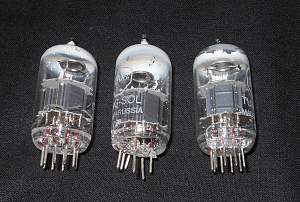Have any of you ever had a rapid, catastrophic failure of new 12AX7 preamp tubes in under an hour of use? Can anyone provide any input of why this would happen?
As you can see from the photo, the tubes have cracked at the bottom and the vacuum has been compromised. One of them fell apart on removal.
All of this in under an hour of use! First, tube 1 (Preamp) failed after about 40 minutes. After swapping it out for an older spare, I continued on for another 10 minutes when the amp died again.
This time it was the other two newbies in the cathode follower and PI sections. The white tops where the giveaway of the tubes loosing their vacuum.
The amp has worked fine (and still does) with older 12AX7ís and 7025ís installed. I canít believe that 3 brand new tubes with a good reputation can be faulty out of the box. Any ideas?







 Reply With Quote
Reply With Quote




